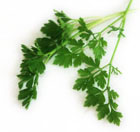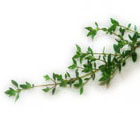Recipe
GOODNESS
 Bay Leaf:
That green headband around Ceasar's head was bay, and it has a long and glorious
culinary history in Mediterranean countries.
Bay Leaf:
That green headband around Ceasar's head was bay, and it has a long and glorious
culinary history in Mediterranean countries.Bay can be bitter when fresh, so let it dry for a few days if you pluck it green from the tree. After drying, it keeps nicely in an airtight jar. It gives up its flavor slowly, which is why you add it to the beginning of slow-cooked soups and stews. It has a slightly musty aroma with shades of nutmeg that can overpower a dish, so only use half a leaf for each serving. Don't forget to pull them out before serving! |
 Parsley:
This refreshing herb is good for your breath and is apparently refreshing to the rest of your body. Like all green herbs, it is loaded with chlorophyll, which is just good for people. It helps you build tissue and fight inflammation. It has even been shown to help manage blood sugars and helps to keep your weight in check. More studies are needed, but it may even help to fight cancer. All that, and a breath freshener too? Who could ask for more?
Parsley:
This refreshing herb is good for your breath and is apparently refreshing to the rest of your body. Like all green herbs, it is loaded with chlorophyll, which is just good for people. It helps you build tissue and fight inflammation. It has even been shown to help manage blood sugars and helps to keep your weight in check. More studies are needed, but it may even help to fight cancer. All that, and a breath freshener too? Who could ask for more? |
 Thyme:
This aromatic herb has anti-inflammatory and anti-oxidant properties and contains thymol, a well-known antiseptic (you might be gargling with it). It's good for the digestion and is supposed to have some aphrodisiac qualities, although that just may be be due to the well-known connection between love and good food.
Thyme:
This aromatic herb has anti-inflammatory and anti-oxidant properties and contains thymol, a well-known antiseptic (you might be gargling with it). It's good for the digestion and is supposed to have some aphrodisiac qualities, although that just may be be due to the well-known connection between love and good food. |
ADVERTISEMENT
Help • Site Map • About Us • Contact Us • Privacy Policy • Press Center
Spice Plan™ Copyright © 2009 by Scott Charles Anderson. All rights reserved.